Table of Contents
Introduction: The Spectacular End of Stellar Evolution
In the grand tapestry of the cosmos, few events rival the awe-inspiring spectacle of a supernova explosion. These cataclysmic events mark the final chapter in the lives of massive stars, culminating in a breathtaking display of energy and destruction. But what unfolds in the aftermath of a supernova? Let’s embark on a journey into the depths of space to uncover the mysteries that follow the explosive demise of these stellar giants.
The Initial Explosion: A Burst of Energy and Light
When a massive star exhausts its nuclear fuel, it can no longer support its own weight against the relentless pull of gravity. The star’s core collapses under its own gravity, triggering a runaway nuclear reaction that unleashes an explosion of unfathomable proportions. This initial supernova explosion releases an immense burst of energy and light, outshining entire galaxies for a brief moment in time.
Stellar Remnants: Neutron Stars and Black Holes
Neutron Stars: The Densities of the Cosmos
In some cases, the core of the collapsing star rebounds, creating a shockwave that propels the outer layers of the star into space. What remains is a dense, city-sized object known as a neutron star. These stellar remnants pack the mass of several suns into a sphere just a few kilometers in diameter, creating gravitational forces so intense that they warp the fabric of spacetime itself.
Black Holes: The Cosmic Abyss
For the most massive stars, the collapse of the core continues unchecked, leading to the formation of a black hole. These enigmatic objects possess gravitational pulls so strong that not even light can escape their grasp, rendering them invisible to traditional observation methods. Black holes represent the ultimate endpoint of stellar evolution, where the laws of physics as we know them break down.
Supernova Remnants: The Echoes of Stellar Death
Shockwaves and Stellar Debris
In the wake of a supernova explosion, the surrounding space becomes littered with a chaotic jumble of stellar debris. Shockwaves from the explosion collide with the surrounding interstellar medium, heating and compressing gas and dust to form intricate structures known as supernova remnants. These cosmic relics serve as a lasting testament to the violent deaths of once-mighty stars.
Cosmic Recycling: The Birth of New Stars and Planets
Enriching the Interstellar Medium
One of the most profound consequences of a supernova explosion is its role in enriching the surrounding interstellar medium with heavy elements forged in the heart of the dying star. Elements such as carbon, oxygen, and iron, essential building blocks of life, are dispersed into space, seeding future generations of stars and planets with the raw materials necessary for their formation.
Stellar Nurseries: The Cradle of New Life
In regions where supernova remnants mingle with vast clouds of gas and dust, gravitational forces begin to sculpt these materials into new stars and planetary systems. These stellar nurseries, illuminated by the glow of newborn stars, represent the birthplaces of future generations of cosmic wonders, perpetuating the cycle of stellar birth and death that has shaped the universe for billions of years.
Conclusion: A Cosmic Symphony of Creation and Destruction
In conclusion, the aftermath of a supernova explosion is a testament to the relentless march of cosmic evolution. From the fiery crucible of stellar death emerge new beginnings, as the remnants of once-mighty stars fuel the birth of future generations of celestial objects. Though the life of a star may end in a blaze of glory, its legacy lives on in the fabric of the cosmos, shaping the destiny of the universe itself.
You will find more resource about Supernova here.
If you want to know about solar eclipse then please read here.
